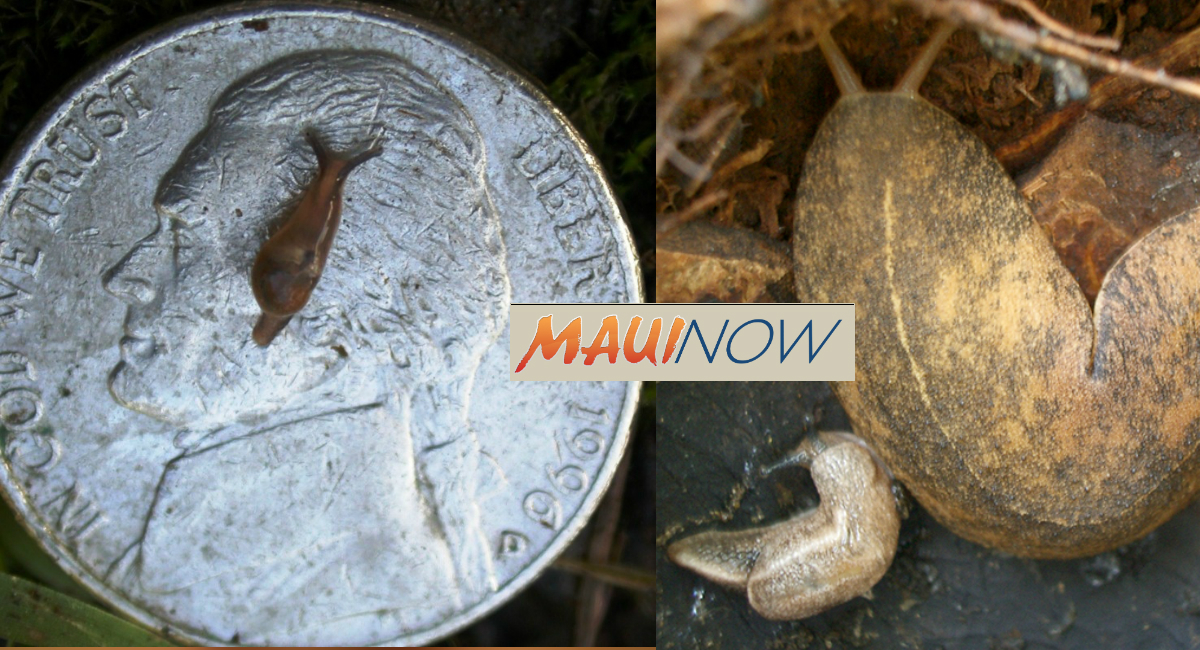Rat Lungworm Confirmed in Maui and Mainland Resident

PC: Hawaiʻi Department of Health and Centers for Disease Control
The Hawaiʻi Department of Health has been conducting detailed investigations of two additional cases of angiostrongyliasis, or rat lungworm disease, contracted in the state.
The two cases are unrelated and were confirmed by laboratory tests conducted by the DOH State Laboratories Division in March. This brings the statewide total of confirmed cases of the disease to three individuals to date in 2018.
One Individual Likely Infected on Maui:
The second case of rat lungworm disease confirmed this year was an adult resident of Maui who became ill in mid-February and was briefly hospitalized. The DOH investigation determined the individual was most likely infected in Maui County, but had a history of travel to Oʻahu and Hawaiʻi Island during the time when the infection may have occurred.
Third Case of 2018 Traced to Hawaiʻi Island:
The third case of rat lungworm disease in 2018 was a visiting adolescent, who traveled with their family to Hawaiʻi Island in January. A resident of New York state, the individual was hospitalized after returning home in late January. Laboratory testing confirmed angiostrongyliasis infection in mid-March. DOH and its local partners have been in close communication with the clinicians providing treatment to the individual as well as public health colleagues in New York. After careful investigation, no clear risk factor causing the visitor’s infection could be determined.
At this time, DOH is unable to provide more specific information on these individuals and their cases.
Health Department Ramps Up Education:
“These recent cases are a reminder that the risk of rat lungworm disease exists statewide and we all need to take precautions to prevent infection,” said Dr. Sarah Park, DOH’s state epidemiologist. “We can all do our part to eliminate risks around our homes, gardens, and farms by controlling rats, slugs and snails, especially during the rainy season. Inspecting and thoroughly washing produce under clean, running water can go a long way in preventing rat lungworm disease.”
Thanks in large part to an appropriation from the 2017 Hawaiʻi State Legislature, DOH has been able to ramp up its education and outreach efforts on rat lungworm disease. In addition to materials created as part of this campaign, the department’s partners have also developed valuable resources to help the community better understand what rat lungworm disease is and how to prevent it:
The University of Hawaiʻi Cooperative Extension program of the College of Tropical Agriculture and Human Resources recently released a new video on “Managing Slugs and Snails in the Garden.” The five-minute locally-produced video provides expert guidance on identifying and removing slugs and snails from properties in Hawaiʻi.
The Centers for Disease Control and Prevention recently completed a brief video detailing the life cycle of A. cantonensis, how people contract rat lungworm disease, and how to prevent it.
Angiostrongyliasis, commonly known as rat lungworm disease, is caused by a parasitic roundworm and can have debilitating effects on an infected person’s brain and spinal cord. In Hawaii, most people become ill by accidentally ingesting a snail or slug infected with the parasite Angiostrongylus cantonensis (A. cantonensis). Symptoms vary widely between cases, but the most common ones include severe headaches and neck stiffness. The most serious cases experience neurological problems, severe pain, and long-term disability.
Tips to Prevent Transmission:
In 2017, there was a total of 18 laboratory-confirmed cases of angiostrongyliasis in the state. The first case confirmed in 2018 was an adult West Hawaiʻi resident. Tips to prevent rat lungworm disease include:
- Inspect, wash and store produce in sealed containers, regardless of whether it came from a local retailer, farmer’s market, or backyard garden.
- Wash all fruits and vegetables under clean, running water to remove any tiny slugs or snails. Pay close attention to leafy greens.
- Control snail, slug, and rat populations around homes, gardens and farms. Get rid of them safely by using traps and baits, and always wear gloves for safety.









